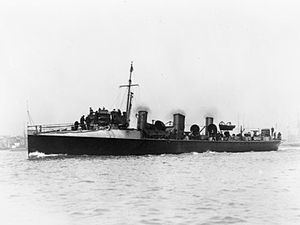Name HMS Bat Laid down 28 May 1896 Construction started 28 May 1896 Length 66 m | Ordered 8 January 1896 Commissioned August 1897 Launched 7 October 1896 Draft 3.8 m | |
 | ||
Out of service Laid up in reserve, 1919 Fate Sold for breaking, 10 June 1919 | ||
HMS Bat was a Palmer three funnel, 30 knot destroyer ordered by the Royal Navy under the 1895 – 1896 Naval Estimates. She was the third ship to carry this name since it was introduced in 1815 for a revenue cutter in service until 1848.
Contents
Construction
HMS Bat was one of four 30-knotter destroyers (Bat, Chamois, Crane and Flying Fish) ordered from Palmer's of Jarrow on 8 January 1896 as part of the 1895–1896 shipbuilding programme, following on from two destroyers (Star and Whiting) ordered from Palmer's on 23 December 1895 as part of the same programme.
She was laid down on 28 May 1896 at the Palmer shipyard at Jarrow-on-Tyne and launched on 7 October 1896. During her builder’s trials she made her contracted speed requirement. She was completed and accepted by the Royal Navy in August 1897.
Pre-War
After commissioning Bat was assigned to the 2nd Fleet and based at Devonport on training duties.
In October 1898, the ship became the first destroyer in the Royal Navy to receive a torpedo fitted for a gyroscope.
In 1899 she was the leader of the Devonport Flotilla under the command of Commander Alexander Ludovic Duff during exercises in July. Commander Pennant Lloyd was appointed in command in January 1900, when she commissioned for the Devonport instructional flotilla. The following month she had her starboard propeller damaged while in the Falmouth harbour, when the destroyer Fairy dragged her moorings and drifted into Bat and other ships of the flotilla. Following repairs in Devonport, she was back in the flotilla in late February. Her next commanding officer, from 1901, was Commander Roger Keyes, who pioneered new aggressive tactics for destroyers during this period. Bat was paid off on 4 January 1902, when her crew was turned over to the destroyer Falcon, which took her place in the Flotilla. After paying off, she underwent repairs to re-tube her Reed boilers.
Bat was deployed to the Mediterranean between 1902 and 1905.
In 1910, Bat was part of the Fourth Destroyer Flotilla, based at Portsmouth and tendered to the depot ship Hecla. By March 1913, Bat was part of the Sixth Flotilla at Portsmouth, which was equipped with older destroyers for patrol purposes. The destroyer transferred to the Eighth Flotilla, based at Chatham in early 1914.
On 30 August 1912 the Admiralty directed all destroyer classes were to be designated by alpha characters starting with the letter 'A'. Since her design speed was 30 knots (56 km/h; 35 mph) and she had three funnels, she was assigned to the C class on 30 September 1913. The class letter 'C' was painted on the hull below the bridge area and on a funnel.
World War I
In 1914 Bat was assigned to the 8th Destroyer Flotilla based at Chatham tendered to HMS Tyne. On the outbreak of war, the Eighth Flotilla was deployed to the Firth of Forth, carrying out patrol duties in support of the Grand Fleet. By January 1915, Bat, although still supported by Tyne, was attached to the Grand Fleet. She remained attached to the Grand Fleet through the rest of 1915 and 1916.
In July 1917 Bat was redeployed to the East Coast Convoy Flotilla, this merging into the 7th Destroyer Flotilla based at the Humber the next month, continuing in escort operations for East coast convoys. She would remain there for the remainder of the war.
On 29 January 1918, Bat collided with the tug Guiana off Whitby, sinking the tug and killing four of Guiana's crew.
Disposition
In 1919 Bat was paid off and laid-up in reserve awaiting disposal. She was sold on 30 August 1919 to Hayes of Porthcawl for breaking.
